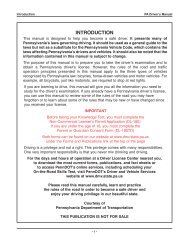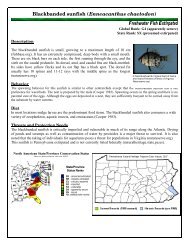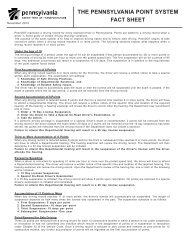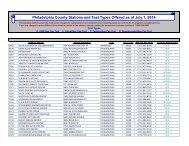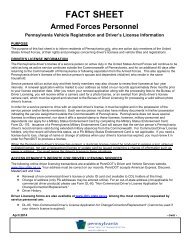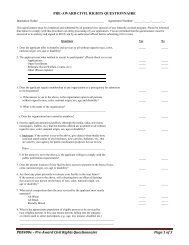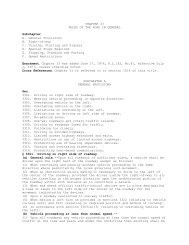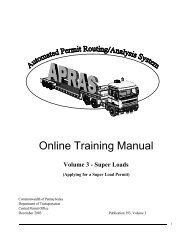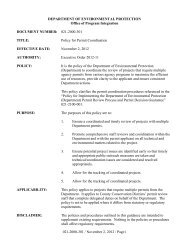fundamentals of driving a school bus - PennDOT Driver and Vehicle ...
fundamentals of driving a school bus - PennDOT Driver and Vehicle ...
fundamentals of driving a school bus - PennDOT Driver and Vehicle ...
- No tags were found...
You also want an ePaper? Increase the reach of your titles
YUMPU automatically turns print PDFs into web optimized ePapers that Google loves.
UNIT G - Fundamentals <strong>of</strong> Driving a School Bus3. Check traffic to the front <strong>and</strong> rear, as well as roadside obstacles such as poles, trees, mailboxes <strong>and</strong>culverts. Clearance on all sides <strong>of</strong> the <strong>bus</strong> is important. You should have traffic visibility for at least500 feet in either direction;4. Use all mirrors <strong>and</strong> look carefully in all directions to observe traffic <strong>and</strong> obstacles, back slowly <strong>and</strong>cautiously into the designated area (see backing information above); <strong>and</strong>5. Make sure to check traffic both ways, reenter the highway, deactivate the hazard warning lights, <strong>and</strong>proceed with extreme caution.STOPPINGUnit F included detailed information on stopping requirements for <strong>school</strong> <strong>bus</strong>es. Stopping a <strong>school</strong> <strong>bus</strong>smoothly <strong>and</strong> within the limits <strong>of</strong> safety is the sign <strong>of</strong> an expert driver. Good drivers have their vehicles undercontrol at all times <strong>and</strong> know braking distances increase greatly as speed <strong>and</strong> vehicle weight increase. Inaddition to knowing the distance required to safely stop their <strong>bus</strong> under all <strong>driving</strong> conditions, skillful driversuse correct stopping procedures, which increase <strong>bus</strong> life <strong>and</strong> lower maintenance costs.Anti-lock Braking SystemsThe U.S. DOT requires that anti-lock braking systems be on air brakes vehicles, (trucks, <strong>bus</strong>es, trailers, etc.)built on or after March 1, 1998 <strong>and</strong> hydraulically braked trucks <strong>and</strong> <strong>bus</strong>es with a gross vehicle weight rating <strong>of</strong>10,000 lbs or more built on or after March 1, 1999. Many <strong>bus</strong>es built before these dates have been voluntarilyequipped with ABS. Your <strong>school</strong> <strong>bus</strong> will have a yellow ABS malfunction lamp on the instrument panel, if it isequipped with ABS.How ABS Helps YouWhen you brake hard on slippery surfaces in a vehicle without ABS, your wheels may lock up. When your frontsteering wheels lock up, you lose steering control. When your other wheels lock up, you may skid or even spinthe vehicle. ABS helps you avoid wheel lock up <strong>and</strong> maintain control. You may or may not be able to stop fasterwith ABS, but you should be able to steer around an obstacle while braking, <strong>and</strong> avoid skids caused by overbraking.Braking With ABSABS is designed to help the driver maintain control <strong>of</strong> the <strong>bus</strong> during emergency braking situations, not makethe <strong>bus</strong> stop more quickly. ABS may shorten stopping distances on wet or slippery roads, <strong>and</strong> many systemswill shorten stopping distances on dry roads. On very s<strong>of</strong>t surfaces, such as loose gravel or unpacked snow,an ABS system may actually lengthen stopping distances. In wet or slippery conditions, you should still makesure you drive carefully, always keep a safe distance behind the vehicle in front <strong>of</strong> you, <strong>and</strong> maintain a speedconsistent with the road conditions.When you drive a vehicle with ABS, you should brake as you always have. In other words:• Use only the braking force necessary to stop safely <strong>and</strong> stay in control; <strong>and</strong>• Brake the same way, regardless <strong>of</strong> whether you have ABS on the <strong>bus</strong>.However, in emergency braking, do not pump the brakes on a <strong>bus</strong> with ABS.As you slow down, monitor your <strong>bus</strong> <strong>and</strong> back <strong>of</strong>f <strong>of</strong> the brakes (if it is safe to do so) to stay in control.Pennsylvania School Bus <strong>Driver</strong>’s Manual • PUB 117 G-13



